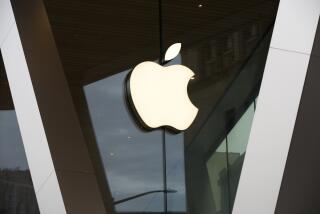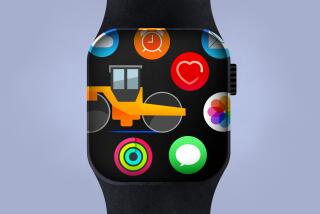Analysts Applaud : Jobs Reveals What’s Next in Computers
- Share via
SAN FRANCISCO — Former Apple Computer Chairman Steven Jobs and his team at Next Inc. shattered the perceived limits of personal computers Wednesday, unveiling what they called a “personal mainframe” for university students, teachers and researchers.
The Next machine, which won’t be generally available until spring, is the long-awaited computer that former whiz kid Jobs has brashly promised will revolutionize higher education.
And, by and large, analysts said Wednesday that the $6,500 machine and its $2,000 accompanying laser printer have lived up to Jobs’ pledge.
“Everything on your wish list is there,” said Jonathan Seybold, publisher of a Los Angeles computer marketing newsletter. Added Paul Saffo, a research fellow at the Institute of the Future in Palo Alto: “It’s a Swiss army knife for propeller heads (computer ‘nerds’).”
Easily the most novel feature of the machine is its inclusion of a “read-write” erasable optical disk that functions as the computer’s main storage system. The device is similar in design and size to an audio compact disk; so far, consumers have been able only to play back recordings on such disks but have not been able to re-record on them.
Although other technology companies--notably Tandy--have promised this technology, Next is the first to deliver the system, which is considered a major advance because it can store 256 megabytes of information, the equivalent of 700 floppy disks, on a single removable disk. (One megabyte represents storage space for 1 million characters of information.)
Much Faster System
In essence, the technology allows users to record vast libraries of information, just as the videocassette recorder has allowed the television watchers to accumulate a virtually unlimited collection of movies and TV shows.
Other features of the machine, which was unveiled to a packed and enthusiastic audience in the 3,000-seat Davies Symphony Hall here, include a data-processing power and speed of 32 megabytes a second. Currently the most sophisticated personal computing systems offer in the neighborhood of 20-megabyte-per-second speed and large mainframe models operate at about 40 megabytes a second.
Jobs repeatedly stressed that the new machine has been designed for and will be sold exclusively to the nearly 3,000 U.S colleges and universities and their estimated 660,000 faculty members and 12 million students, a total market that analysts have estimated at $1 billion and growing. The machine will be sold through campus outlets only and will not be available through general retail or computer stores.
When asked how corporate and non-college users could buy a Next computer, Jobs said only: “Enroll.”
Noting that these institutions of higher learning often have billion-dollar annual budgets, Jobs quipped: “These are Fortune 500 companies disguised by another name.”
Although the computer’s $6,500 price tag, reportedly twice its original target price, is fairly steep, analysts said Jobs is initially targeting the faculty and grant-funded research segments of the market.
Expect Expansion
The strategy is designed to give the company sufficient time to reduce manufacturing costs while allowing software developers and faculty members a chance to develop the classroom and research applications that will lead students to choose a Next machine over such currently popular models as the Macintosh from Apple Computer and Sun Microsystem’s 386i.
But the speed and power of the Next machine--plus Jobs’ own penchant for high visibility products--left many analysts seriously doubting whether he would be content for long in the higher education market.
“He may be starting in the university market now, but there’s no reason he shouldn’t move to the general business market,” said Michelle Preston, a personal computer analyst for the Salomon Bros. investment firm. “The price and the hardware are there. It only needs the software and that will come.”
Even if Jobs sticks to the education market, Preston said, the Next machine ups the ante for business machine makers who will be forced to meet its performance. “It’s a significant technological advance from what’s out there now and it makes you question where all those research and development dollars at other companies have gone. We should be finding out.”
Jobs also used the unveiling event to confirm longstanding industry speculation that Next had agreed to license its innovative software technology to industry leader International Business Machines Corp., which is believed to be ready to use the Next programming throughout much of the IBM computer lineup.
Industry sources have placed the initial value of that deal at $10 million.
However, money may be the least of the considerations. Jobs said the alliance will benefit Next because it will propel the development of new software programs that will operate on both Next and IBM machines, thus vastly enlarging the potential market for the programs.
Could Squash Rival
Jobs said the deal with IBM, a company he had previously criticized for what he called its stodgy ways, was the result of a chance meeting he had with IBM Chairman John Akers at Washington Post Publisher Katherine Graham’s birthday party last year. He said Akers invited him and his staff to visit IBM headquarters in Armonk, N.Y.
Although the IBM deal could benefit Next, there was immediate speculation that the computer giant could use the alliance to squash its tiny rival in the education market.
And that wasn’t the only potential problem industry leaders found. Mitch Kapor, founder of the firm that makes Lotus 1-2-3 software, said the Next machine’s use of optical disks could impede development of mass appeal software because of the relatively high cost of the disks compared to the magnetic disks now widely used. Jobs said the blank disks cost about $50, while blank floppy disks cost well under $10 each.
“Steve is pushing the technology in all the right directions, and it’s great. But until the software is developed and we get our hands on it we won’t know for sure,” Kapor said.
Clearly the audience at the unveiling was most excited about the Next system’s stereo sound system and its potential for synthesizing and recording sound. And Jobs did everything he could to foster the enthusiasm.
As part of his three-hour demonstration, he used the machine to replay recordings of an atomic bomb exploding, Martin Luther King Jr. delivering his “I Have a Dream” speech and John F. Kennedy delivering his inaugural address.
Members of Next’s academic advisory board speculated that music departments on college campuses would be among the first to explore its new potential to write and play music.
WHAT’S NEXT Price: $6,500 plus $2,000 for laser printer. Looks: Basic black with a 17-inch ultra-high-resolution monitor, keyboard and mouse. The computer itself is encased in a 1-foot black magnesium cube, connected by a 3-foot cable to monitor. Users may place the processing unit away from the terminal and keyboard and thus distance themselves from its noise and heat. Features: Erasable 256-megabyte compact disk allows for enhanced storage, searching and indexing capabilities and stereo-quality sound and high-resolution screen. Robot-built printed circuit board rivals big computers in power and speed, “a mainframe on two chips,” according to Next. System runs on a simplified UNIX-based operating system, the standard in higher education. Uses Display PostScript software for high-resolution printing. Connections: Link to industry-standard network called Ethernet will allow Next to share files with other types of computers. Mathematica software is of special use for sophisticated math equations. Also included in the basic software package are built-in reference sources, including a thesaurus, dictionary and quotations, the complete works of Shakespeare and on-line access to high-fidelity musical scores. Biggest Investor: H. Ross Perot with $20 million, followed by Steven Jobs with $12 million. Quote of the day: “It’s a Swiss Army knife for propeller heads (computer nerds).” --Paul Saffo, research fellow at Institute of the Future






